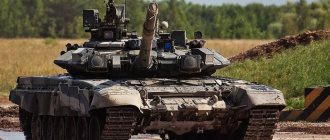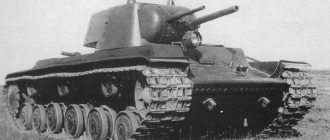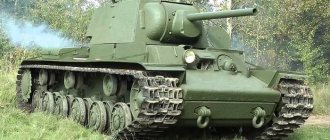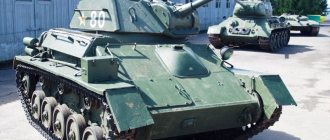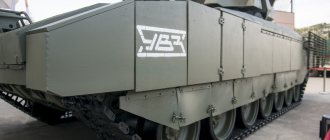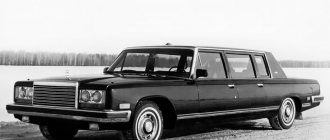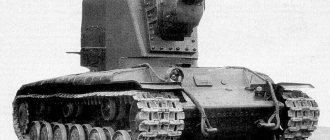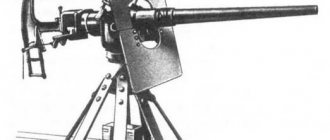After the collapse of the Soviet Union, hardly anyone seriously expected that Russia would be able to present the world with a new main battle tank in just a couple of years. Nevertheless, it happened, and for more than two decades the T-90 tank has been a star, a topic of heated discussion, both among experts and among amateurs.
Propaganda-oriented sources immediately rushed to declare it superior in all respects to its possible competitors. Skeptics declared the T-90 deliberately outdated. The actual absence of this combat vehicle among the troops and the promise of designers from competing factories to provide more advanced models (the “Black Eagle” project) added fuel to the fire. Now that operating experience has been accumulated, it is already possible to draw conclusions about who was right.
Brief history of creation
The fleet of armored vehicles of the Soviet troops in the eighties was distinguished by its diversity. In service at the same time were: the first-born of the Soviet MBT T-64, a cheaper and more technologically advanced competitor to the T-72, a representative of the new generation T-80 with a gas turbine engine, and its diesel “relative” T-80UD, and these are just the main ones.
In addition to them, the modernized “old men” T-55 and T-62 also remained in service.
The T-80 was considered the most modern and efficient, but at the same time it turned out to be expensive and difficult to manufacture and operate. In 1988, work began to bring the reliable and trouble-free T-72 to the required efficiency.
In the spring of 1991, the experimental “Object 188” was recommended for adoption.
It was supposed to be called “T-72BU”, but it never made it into the Soviet army. It became the newest vehicle of the Russian army, and was christened the T-90.
The name change is associated with the desire of Russian President B. Yeltsin to have a completely new tank. It is also possible that after the war with Iraq in 1991, the reputation of the T-72 was seriously tarnished, and the new designation could help sell the equipment for export.
Forward to export!
Almost simultaneously with the basic “Object 188”, its export version, the “Object 188C”, was also developed, mainly characterized by lower security and differences in configuration. Outwardly, they were practically no different. Although permission to export the T-90S was received simultaneously with the adoption of the basic vehicle in 1992, the vehicle was not able to immediately break through beyond Russia. At that time, officials from Rosvooruzhenie relied on the more advanced and expensive gas turbine T-80U, which, in their opinion, was more attractive for export. The military was of the same opinion. Even in 1996, when the T-90 was officially chosen as the tank for re-equipping units of the Russian Army, the then head of the GABTU, Colonel General A.A. Galkin spoke out against the T-90, considering the T-80U to be a more promising vehicle. True, only Cyprus and South Korea managed to sell T-80U tanks abroad, and then the latter to pay off the Russian debt to this country. A contract worth $172 million for the purchase of 41 T-80U/UK for arming the Cyprus National Guard was signed in April 1996. Delivery of the tanks began in the summer of that year and ended in June 1997. In 1996, Russia officially announced the export of 33 T-80U tanks to South Korea. For these deliveries, Russian debt in the amount of $210 million was written off. According to other sources, by 2007, South Korea already had 80 such tanks. In both cases, these were not newly produced vehicles, but vehicles from the Armed Forces.
The T-90S was first exported abroad only in 1997, when it was presented at the IDEX-97 arms exhibition in Abu Dhabi. In the meantime, the search for foreign customers was ongoing, the export T-90S was slowly being improved. First of all, the characteristics of the night sighting system were improved.
Even during the ground operation to liberate Kuwait - “Desert Sword”, in 1991, American and British tank crews, taking advantage of a significant advantage in target detection range in conditions of limited visibility, which provided them with the use of modern thermal imaging night vision systems, in a series of night battles 25 -February 26 inflicted heavy losses on Iraqi troops. Since the movement of Iraqi tanks during the day was practically impossible due to the air supremacy of allied aviation, tank battles, as a rule, took place at night. Thermal imaging sights also proved useful during the day, since visibility was often limited due to smoke from burning oil fields, damaged equipment, dust squalls or rain.
Compared to the old second-generation infrared sights installed on the T-72 and T-90 tanks of the 1992 model, thermal imagers were devoid of many shortcomings. In particular, their work did not deteriorate in bad weather conditions, the sight was not “blind” from the flashes of shots, it did not need external illumination, which would unmask the tank (large infrared illumination spotlights disappeared from Western tanks in the late 70s).
It is not surprising that foreign customers, when purchasing armored vehicles, paid great attention to the availability and quality of thermal imaging sights. But since Russia did not have its own production of thermal imaging sighting systems, the demonstration samples of the T-90S had to be equipped with Belarusian sights, which used the French Catherine-FS thermal camera.
Another direction for improving the T-90 turned out to be forced. When in Russia in the second half of the 90s, due to lack of demand, large-scale production of tank turret casting at ZSO (the Sergo Ordzhonikidze plant in Chelyabinsk) “died” due to lack of demand, and tank turrets cast in small batches turned out to be extremely expensive, designers had to look for a way out . Fortunately, there was a “backlog” from the times of the USSR, when the design of a tank turret for the T-72, welded from rolled armor plates, was worked out. With the same strength and protection as cast, it had less weight, in addition, the internal volume increased slightly and projectile resistance increased. The grimace of the Soviet planned economy was that the welded tower was not put into production earlier because they did not want to disrupt the established production of cast towers. Now the welded tower has been given the green light. The first welded turrets for the T-90 were manufactured in 1998 and successfully passed full-scale shelling tests at the training ground. Since 2002, all produced T-90S have already received a welded turret.
Composition of the T-90MS fire control system Illustration by JSC NPK Uralvagonzavod
A similar story happened in Ukraine. With the closure of the production of cast towers at the Mariupol plant, which equipped the T-80UD, in Kharkov at the plant named after. Malyshev also switched to a welded tower. As a result, 175 T-80UD tanks, out of 320 delivered to Pakistan under the contract signed between this country and Ukraine in 1996, were equipped with welded turrets.
Tank structure
The T-90 hull is welded from armor sheets, the turret of early models is cast. The length of the hull (without a gun) is 6.8 m. Later modifications had welded turrets. The frontal armor of the hull (upper part) is made of combined armor, installed at an angle of 680. The sides, 70-80 mm thick, are vertical, without slope. This is higher than most analogues (although it protects equally poorly from being hit by an armor-piercing projectile).
The sides are covered with rubber-fabric screens, partially with dynamic protection units. For additional protection, it is possible to install anti-cumulative grilles, which have become widespread in the last decade.
In the design of the T-90 turret, combined armor is used to protect the frontal projection, and partially the sides and roof.
The height reaches 2.2 meters, and the T-90 weighs about 46 tons.
The T-90 was equipped with the Shtora active protection system. If it is irradiated by a guidance laser, the Shtora notifies the crew about this and fires aerosol grenades. The resulting smoke screen not only camouflages the tank visually, but also scatters the laser beam.
The first dynamic protection that appeared on the T-90 was designated “Contact-5”. It did not protect against tandem charges and did not improve resistance against armor-piercing shells. The newest model of the Relikt defense complex, which the T-90AM received, reduces the armor penetration of enemy shells by 40% and protects against heavy ATGMs with a tandem charge. In addition, modernized blocks for the Contact system raise its efficiency to almost a “relic” level.
The dense layout has a negative impact on survivability - fuel tanks have to be placed in the fighting compartment. However, in later modifications they were isolated from the crew by steel bulkheads. The automatic loader remains vulnerable - it is located behind the weakly protected side directly under the crew. We can say that the commander and weapon operator are sitting on the shots.
Crew accommodation has remained unchanged since the introduction of the T-64. The driver's seat is located in the front center of the body. The gunner is located on the left half of the turret, and the tank commander is located to the right of the gun.
The T-90 inherited the power plant from the T-72.
This is a multi-fuel 12-cylinder diesel engine V-84MS with a volume of 38.8 liters and developing 840 hp. In the T-90A modification, the engine was replaced with an improved version of the B-92, based on the same block. Its power reaches 1000 hp. With. The transmission is 7-speed and includes separate planetary gearboxes. Hydraulic drives are used to facilitate control. The T-90 has a torsion bar suspension and hydraulic shock absorbers.
India is a country of elephants and tanks
Deliveries of the T-80UD to Pakistan greatly contributed to the export success of the T-90S. Pakistan's longtime rival, India, could not remain indifferent to its restless neighbor receiving a new tank division; this violated military parity in the region. On the other hand, there was no longer any hope of meeting the deadlines for the development program of India’s own Arjun tank. Therefore, given the significant number of Soviet T-72M and T-72M1 tanks available in India, the Indians naturally showed interest in the T-90. Preliminary negotiations, consultations and approvals lasted for more than two years, until in April 1999 an agreement was reached to test three T-90S in India. All three tanks were different from each other. Thermal imaging sights were different - “Nocturne” or “Essa”, only one tank had the Shtora system installed, two tanks had cast turrets, and the third had a welded one.
In May-August, the T-90S underwent a test program in the Thar Desert, in extreme conditions - during the day the heat here reached 50°C. The vehicles traveled 2,000 km across this hot desert and then fired 150 rounds. The Indian military was satisfied with the test results, and a long process of agreeing on the terms of the contract began. In the east they love and know how to bargain, so the final signing of the contract took place only after almost a year and a half - on February 15, 2001 in Delhi. Under its terms, Russia undertook to supply India with 310 T-90S tanks, which was enough to rearm the tank division (by this time Pakistan had already received all 320 T-80UD tanks). Of these, 124 were assembled in Russia and delivered to the customer in finished form, and 186 tanks were to be assembled from assembly units in India itself at the state-owned HVF (Heavy Vehicles Factory) plant in the city of Avadi (Tamil Nadu). The total value of the contract was $800 million, and deliveries under it were fully completed in 2003.
So what did Indians get for their money? As a result of persistent demands, they received not just an export T-90S in its original 1992 configuration, but a vehicle that combined (in their opinion) all the best of the three models proposed for testing. It is interesting that this “Indian” T-90S was significantly superior to the T-90 of the 1992 model, supplied by Uralvagonzavod for the Russian Army. On Indian tanks, instead of the BuranPA night sight, which was installed on Russian vehicles, a more advanced thermal imaging gunner's sight, Essa, jointly produced in France and Belarus, was installed. The commander received the PNK-4C "Agat-S" sighting and observation system. The Indians abandoned the Shtora-1 optical-electronic suppression complex, and in place of its illuminators in the front part of the turret, additional trapezoidal containers of the Kontakt-5 dynamic protection complex were mounted, as a result of which the turret’s security increased compared to Russian tanks. Interestingly, the Indians also demanded that anti-nuclear defense be strengthened. At their request, the thickness of the anti-neutron lining was almost doubled, despite the fact that the anti-nuclear protection of the Russian T-90s was already considered quite powerful. Considering that the eternal enemies - India and Pakistan - are both members of the nuclear club, such a requirement suggests that the Indian military does not rule out the use of tactical nuclear weapons in a likely armed conflict with Pakistan. All Indian T-90S (except for the first forty vehicles) were equipped with welded turrets, a reinforced chassis, as well as a 1000-horsepower V-92S2 diesel engine (recall that the Russian T-90 at that time had a V-84 diesel engine with a power of 840 hp .).
T-90 armament
The main caliber of the tank is the “traditional” 125mm Rapier cannon for Soviet and then Russian vehicles. The T-90 received its version 2A46M-5, the accuracy of which (compared to older versions) was increased by 15-20%. The gun stabilizer was two-plane.
The carousel-type automatic loader was inherited from the T-72, but can now be controlled from the commander’s seat. There are 22 shots placed in the “carousel”, the rest (up to 43 in total) are stored in the housing. The crew either loads the gun itself with them, or can reload the automatic loader.
To destroy enemy armored vehicles, the T-90 uses armor-piercing sub-caliber projectiles, for example, 3BM46 with a uranium core. The effective range when firing such projectiles is up to 3000 m. The loading system of the T-90S tank has been redesigned and allows the use of the latest high elongation projectiles, such as 3BM60. To increase the effectiveness of hitting infantry in shelters, a fragmentation projectile with the possibility of detonation in the air and ready-made submunitions was developed.
An alternative to sub-caliber “blanks” can be the 3BK31 cumulative projectile, the triple warhead of which can overcome double dynamic protection. The T-90 can launch guided missiles through its gun barrel. The laser-guided 9M119M "Invar" ATGM has a tandem cumulative warhead with armor penetration (normal) up to 700 mm. The ammunition can be supplemented with missiles with high-explosive and thermobaric charges. The missiles will allow you to hit a moving target at distances of up to 5000 m.
The cannon, as on previous tanks, is paired with a 7.62mm PKT machine gun.
Its ammunition capacity is eight 250-round cartridge belts, and its practical rate of fire is up to 250 rounds per minute. The first production vehicles had a remote-controlled NSVT heavy machine gun as an anti-aircraft gun. Later it was replaced by a similar in appearance, but different in design, KORD machine gun.
Electronic equipment
The Irtysh fire control system was inherited from early tanks from its predecessor, the T-80. But the already modified T-90A tank received a new fire control system (FCS) 1A42. It includes an aiming and rangefinder guidance device (combining a laser rangefinder with a sight) and an automatic electronic ballistic computer 1B528-1.
The T01-K04 observation device makes it possible to fire not only from an anti-aircraft machine gun, but also from the main gun. At night, it can operate in both passive and active (with target illumination by an IR illuminator) mode.
In subsequent series, the control system was modernized, and modifications of the AM (SM) tank received the latest Kalina system. This multifunctional complex combines not only sights and computers - it integrates the tank into the electronic battalion control system, increasing the efficiency of interaction with other armored vehicles and infantry.
Thermal imagers of early machines were early models and were significantly inferior to similar foreign ones.
On later series (and some export versions), French-made thermal imagers were installed. For communication, the R-163-50U radio station operating in the VHF range is used. Commander models received, in addition, a shortwave radio with a range of up to 50 km.
What's good about the T-90M?
In 2022, at one of the events of the Ministry of Defense, the modernized T-90M tank was shown for the first time. By now, such equipment has passed basic tests and should soon go into service with the troops. The T-90M project provides for perhaps the largest modernization of the base vehicle of all time, due to which it should receive improved characteristics and expanded capabilities. Let's look at what solutions the new project offers, and also determine what they will give to the updated tank.
Let us recall that the T-90M MBT was created as part of the Breakthrough-3 development work. This R&D project involved combining the experience of previous projects and using new solutions. All this provides a serious increase in performance. Thus, it was previously reported that during real exercises, the modernized T-90M tank significantly surpassed the T-90A combat vehicle in combat effectiveness. Back in 2022, a contract was signed for the serial production of such equipment, and the first vehicles are expected to be delivered to the army in the near future.
The armor is strong
The key characteristic of any tank is its survivability. The T-90M project provides for the use of a number of new means and components that will increase the level of protection and reduce the negative consequences of damage to the vehicle.
Prototypes of the T-90M were demonstrated several times with the "Cape" kit. Special multi-layer covers on the hull and turret are designed to reduce the visibility of the armored vehicle in different ranges, which reduces the likelihood of its detection by enemy aircraft or ground means. As a result, the tracking distance is reduced and the overall effectiveness of the attack decreases.
In order to repel the threat “at distant approaches,” the tank can be equipped with the Arena-M active protection complex. Such a system must automatically monitor the situation, detect incoming ammunition and destroy it with a return shot. However, it is not yet completely clear whether the production T-90M will receive the new KAZ. It is quite possible that they will have to work without such equipment - like other tanks in our army.
The standard combined armor of the hull and turret forehead is complemented by a new overhead protection. The frontal projection and some other surfaces are equipped with modern dynamic protection of the “Relic” type. Other parts of the tank are covered with screens. According to known data, the Relikt DS is several times more effective than the Kontakt-5 DS used on the T-90 before the current modernization.
The internal volumes of the tank have been significantly rearranged and modified in order to reduce the risks of damage. Thus, new lining screens have been introduced, designed to contain secondary fragments and protect the crew or main instruments. Also, some dangerous elements have been removed from the internal compartments. Inside the hull, the horizontal conveyor of the automatic loader is preserved, while other stowage is moved to the aft compartment of the turret. The tank rack was also removed from the bow of the hull, which reduced the risk of fire.
The T-90M tank received a deeply modernized turret with a number of characteristic features. First of all, such a turret has a developed aft niche in which stowage for ammunition is organized. Under normal conditions, the firing compartment is isolated from the fighting compartment and crew.
Thus, the T-90M is seriously different from previous armored vehicles of its family in terms of survivability. If there is a KAZ, anti-tank ammunition has minimal chances of breaking through to the tank. If he succeeds, penetration of the remote sensing or lattice screens and the armor underneath them is not guaranteed. If this happens, the crew and equipment are protected from the flow of fragments. Dangerous areas, entering which could lead to fatal consequences, have been sharply reduced.
Our tanks are fast
Once again, the modernization of the T-90 involves modifications to the power plant. The T-90M project uses a V-92S2F diesel engine with a power of 1130 hp. Together with the transmission units, it forms a monoblock system, which in a known manner facilitates maintenance and repair. The combat weight of the tank does not exceed 50 tons, thanks to which the V-92S2F engine gives it a specific power of at least 22.5 hp. per ton. As a result, an advantageous balance between mobility and fuel consumption is achieved.
According to previously published official data, the maximum speed of the T-90M on the highway reaches 60 km/h. Power reserve – 550 km. The cross-country ability parameters have been maintained at the level of previous armored vehicles of the family.
In accordance with current trends in recent years, the T-90M receives an auxiliary power unit. This diesel generator is designed to generate electricity and ensure the operation of radio-electronic equipment when the main engine is turned off.
The processing of internal volumes affected the external equipment of the tank. Due to the removal of the front tank rack, it was necessary to provide a new fuel container. In order to achieve the maximum possible power reserve, it is proposed to use three external tanks. Two fuel barrels are mounted on the rear hull plate, and on the left fender next to the engine compartment there are mounts for the third.
It should be noted that the installation of a third external barrel tank has already become a reason for criticism. It is noted that it is inconvenient to work with such a container due to the significant height of its installation. In addition, the third barrel on the shelf can interfere with the all-round aiming of the gun at low elevation angles. However, the fuel from this barrel can be used first, and by the time the battle begins, you can get rid of both the container itself and the problems associated with it.
There is no exact information about the modification of the chassis. Apparently, the T-90M retains the suspension, rollers and tracks of existing vehicles. These units were designed with a certain reserve, and their replacement is not required in the new project.
Thundering with fire
The T-90M receives an updated weapons system based on modern components. However, the update did not affect all its elements. Thus, in the past it was stated that the modernized tank would receive a 2A82 smoothbore gun-launcher. However, later, at the insistence of the military department, the time-tested 2A46M gun was retained in the project. At the same time, a number of other new systems were introduced into the project.
The turret retains an automatic loader that is compatible with modern separate-case-loading tank ammunition. The machine's conveyor holds 22 rounds; the remaining ammunition is transported in the aft niche of the turret, separated from the habitable compartment. According to various sources, the machine gun can work with modern sub-caliber armor-piercing shells, which have increased dimensions and show improved characteristics.
The improved tank receives the Kalina fire control system, already used in projects of the T-90M family. This control system includes a combined day-night sight for the gunner “Sosna-U” and a panoramic sight for the commander of the PAN PC. There is an automatic target tracking device, a two-plane weapon stabilizer, means of identifying friend or foe, navigation aids, etc. The control system is integrated with the tactical information management system, which allows you to transmit and receive data about targets on the battlefield.
With the help of such fire control means, the tank is capable of fighting at any time of the day and in any weather conditions. Ensures detection of targets with subsequent attack or issuance of target designation to other tanks. Also, information about the situation can come from outside. A characteristic feature of the Kalina fire control system is a high degree of automation, which speeds up the response to incoming threats and reduces the load on the crew.
The tank's auxiliary armament consists of two machine guns. One of them is paired with a cannon, the second is installed on the roof of the turret on a remote-controlled combat module T05BV-1. The PKT machine gun with a caliber of 7.62 mm is used as a coaxial machine gun. The combat module can be equipped with normal or large caliber weapons. Thanks to the use of the T05BV-1 DUMV, tankers have the opportunity to fire from all available weapons without leaving the protected volume.
Our people are full of courage
The T-90M project also provides for a major redesign of the habitable compartments, associated with improving their equipment and increasing ergonomic characteristics. The crew of the tank, as in previous upgrades, consists of three people. Their placement has also not changed: the driver takes a place in the bow of the hull under his own hatch, the commander and gunner work in the turret, on the sides of the gun.
The crew workstations in the turret have all the necessary equipment for working with the fire control system and other systems. The T-90M differs from its predecessors in some new devices included in its control system. In addition, new functions are provided. Thus, the commander is asked to monitor the situation using viewing devices on the hatch or a panoramic sight. When a target is detected through one of the triplexes, the commander can use the automatic system for turning the panoramic sight into the desired sector. This speeds up the identification and attack of targets. In addition, for the first time in the T-90M line, the commander receives a remote control for selecting ammunition for loading into the gun. Previously, the type of projectile was set only by the gunner.
It is proposed to replace one of the driver’s periscope devices at night with a three-channel viewing device TVN-10. This product has one optical and two television channels with signal output to a monitor. Driving the tank in different conditions is also simplified by the use of a set of video cameras that form an almost continuous observation field around the tank.
Internal communication between tank crews is provided by an intercom for three subscribers. The external radio station R-168-25U-2 “Aqueduct” with two independent modules is responsible for the external one.
Russian tank crews will be in service
The contract for the supply of the first batch of serial T-90M MBTs to the Russian army was signed in August 2022. According to its terms, NPK Uralvagonzavod must transfer 30 new types of armored vehicles to the armed forces in 2018-19. It was reported that 10 tanks would be built from scratch, and the remaining two dozen vehicles would be converted from previous T-90 modifications that were temporarily out of service.
Last year, at the Army-2018 military-technical forum, another contract for T-90M tanks was signed. This time we were talking about 30 newly built armored vehicles with delivery of the entire batch in 2019. Thus, to date the army has managed to contract 60 T-90M tanks. Two-thirds of this equipment needs to be built anew, and the remaining 20 tanks will appear as a result of modernization. The last of the 60 vehicles ordered should go into service before the beginning of next year.
Perhaps the process of modernizing existing tanks or building new ones has encountered certain difficulties. Because of this, the first T-90Ms were unable to enter the army last year. However, in February, reports appeared in the domestic media according to which the first T-90Ms will enter service with the troops this year. In the absence of any serious problems, both batches of 60 tanks could go into service with the army this year.
What will happen after completing two current orders is unknown. It is very likely that NPK Uralvagonzavod will receive new contracts for the modernization or construction of T-90M tanks, and the army will continue to increase the number of such equipment. However, details of such plans have not yet been officially published.
It is known that about 350 T-90 MBTs of two modifications are in use in Russian army units. About 200 more armored vehicles are in storage. Thus, the newest modernization project with the letter “M” has good prospects in terms of quantity. If there is a corresponding desire of the Ministry of Defense, as well as with the necessary financial capabilities, several hundred tanks can be upgraded. In parallel, mass construction of completely new equipment can be carried out.
Tank of the future
Developers and the military department regularly publish individual information about the newest T-90M tank, but a significant part of the data is still not subject to disclosure. However, even the available information shows an increase in the basic characteristics and capabilities of the improved tank, which should have a positive impact on the capabilities of the troops as a whole.
From the available data it follows that the T-90M is a completely modern armored combat vehicle that meets current requirements and is capable of continuing to serve for a long period. It can become a successful and effective replacement for older versions of the T-90, as well as a good “coworker” for the modernized T-72B3 and newly built T-14. The two types of modernized equipment will form the basis of armored units for some time and make a key contribution to the combat effectiveness of the ground forces.
The first MBT modifications of the T-90M will enter service this year. 60 tanks have been contracted and are to be built or modernized in the very near future. In the future we can expect continuation of their production. Thus, Russian armored units are expecting a new large-scale update of the equipment fleet, designed to have a positive impact on their combat effectiveness, and it will be carried out with the help of a modern and decent armored vehicle.
Based on materials from the sites: https://uralvagonzavod.ru/ https://interfax.ru/ https://tass.ru/ https://tvzvezda.ru/ https://rg.ru/ https://ria. ru/ https://vpk.name/ https://otvaga2004.ru/ https://bmpd.livejournal.com/ https://gurkhan.blogspot.com/
Performance characteristics
The table shows the technical characteristics of the T-90A, as the most common model, and its closest analogues and competitors.
| T-90A | Leopard 2A6M | Challenger 2 | |
| Length/Width, mm | 9530/3780 | 6670/3700 | 11570/3520 |
| Combat weight, t | 46,5 | 68,5 | 62,5 |
| Crew, man | 3 | 4 | 4 |
| Main weapons, ammunition | 125mm smoothbore gun 2A46M-5, 43 rounds | 120mm smoothbore gun Rh-120, 42 rounds | 120 rifled gun L30E4, 52 rounds |
| Automatic loader | Eat | — | — |
| Auxiliary weapons | 1 x 7.62 mm PKT machine gun, 1 x 12.7 mm KORD machine gun | 2 x 7.62 mm MG3 machine guns | 2 x 7.62 mm L94 and L37 machine guns |
| Guided weapons | Reflex-M | — | — |
| Suspension | Torsion bar | Torsion bar | Hydropneumatic |
| engine's type | 12-cylinder diesel V-92S2 | 12-cylinder diesel MB 873 | 12-cylinder diesel CV-12 |
| Power plant power, l. With. | 1000 | 1500 | 1200 |
| Maximum speed, km/h | 70 | 72 | 56 |
| Cruising range, km (on highway) | 550 | 550 | 400 |
According to the figures, the Russian tank is equal to its competitors in terms of speed and reserve. In terms of strategic mobility, it is superior due to its lower weight and dimensions, making it easier to transport. It is possible that a more advanced Leclerc automatic loader could give it some advantages in battle due to its high rate of fire.
It is also worth mentioning that the T-90’s loading system had to be modified to allow the use of new shells (of greater length), limiting the combat capabilities of early tanks.
The advantage of Russian tanks (not only the T-90) is the presence of a standard fragmentation projectile.
Most Western competitors consider a cumulative fragmentation projectile to be a “multipurpose” ammunition, while the British still use armor-piercing high-explosive ones. On the other hand, the Americans developed both grapeshot and concrete-piercing shells for the Abrams.
Guided weapons are still not widely used (one can only name the Israeli LAHAT missiles). At the same time, there are still no known cases when a tank had to use an ATGM in battle.
Modifications
The T-90 linear tanks were followed by a command version - the T-90K, equipped with an additional radio station and navigation system. Since 2004, deliveries of the T-90A with a more powerful engine, reinforced armor and improved thermal imagers began. In 2006, this tank also received a command version, the T-90AK, also with more powerful radio navigation equipment.
The “Breakthrough” project led to the appearance of seriously redesigned T-90 tanks. The T-90AM modification turret received a compartment to accommodate additional ammunition. Other changes include a steering wheel instead of control levers and a transmission that automatically changes gears.
And the T-90M version received a new 2A82 cannon and a different layout - the fuel tanks and ammunition were moved to increase survivability.
Separately, it is worth mentioning tanks created specifically for export. The T-90S and T-90SK were generally similar to the original T-90, but the Shtora system searchlights were not installed on them. The T-90SA and T-90SKA models were produced especially for Algeria. Modified for licensed assembly in India, the T-90 even received its own name “Bishma”.
The newest tank for export deliveries received the T-90SM index, and according to its data corresponds to the T-90AM tank. The T-90 chassis was used to build engineering equipment: artillery “self-propelled guns” and MLRS. The original “Fire Support Combat Vehicle”, which covers tanks in battle, deserves special mention.
Malaysian false start
In 2000, inspired by the emerging success in India, the Russians entered the T-90S to participate in an international tender for the purchase of tanks held by Malaysia. For testing, a T-90S copy, modernized after testing in India, with an air conditioner installed, was delivered to Kuala Lumpur airport. Together with the T-90S, the Polish RT-91 Twardy tank (which is a modernization of the Soviet T-72M), the Ukrainian T-84 and the Swedish light tank CV90 120 also underwent comparative tests as part of the tender. The tests took place from June 19 to August 21 , and the local military was mainly interested in the mobility and operational reliability of tanks in difficult local conditions. The vehicles were asked to travel about 2,800 km through the jungle, mountainous terrain, through wetlands and water obstacles. During this “race” in the very center of the jungle, the T-90, not without the “help” of a Malaysian driver (the tests were carried out by mixed Russian-Malaysian crews), was pulled off a washed-out clay road into a ditch, from where it was only recovered through the efforts of, according to one version, two Hyundai excavators, and according to another, the T-90S was evacuated using a 50-ton Japanese KATO crane, paying 5 thousand dollars for this. But despite all the odds, the T90S successfully reached the finish line.
T-90MS - the compartment for part of the ammunition in the rear of the turret is clearly visible
T-90MS design details - commander's hatch, remote machine gun mount
True, the results of the Malaysian competition were quite unexpected. Despite the fact that during testing the Polish PT-91M was significantly inferior to both the Russian T-90S and the Ukrainian T-84 in most key indicators, in April 2002 the Malaysian government announced its decision to purchase 48 PT-91MZ tanks and six ARVs. WZT-4" in Poland. The total contract amount was $370 million. Russian experts claim that one Polish tank cost Malaysia approximately $4 million, or 1.2 million more than the Russian T-90S that participated in this tender. According to one version, this decision was explained by a policy of diversification - Malaysia purchased Su-30MK fighters from Russia, and the contract for tanks was given to Poland; according to another, it was due to banal corruption.
Use in battles and traces in the history of tank building
There are statements about T-90s participating in the first campaign in Chechnya, but there is no documentary evidence of this. But his participation in the Syrian conflict is a fact. T-90 tanks of the Russian army are used in Syria.
For more than two years, only 2 tanks were lost, and 2 more were disabled.
A video has become famous showing a T-90 remaining intact after its turret was hit by a TOW missile. But a published photo of a T-90 with a torn off turret proves that the ammunition rack remains its vulnerable zone.
Perhaps it would be correct to say that the T-90 itself is “a mark in the history of tank building.” The trail left behind by the ideas first materialized in the T-64. The T-90 absorbed all the best from its predecessors - the reliability of the T-72, the technical “advancement” of the T-80.
The T-90 tank became the best and most powerful vehicle in this development ladder. And at the same time it marked its completion, when a completely new T-14 tank was developed. At the same time, in terms of its combat qualities, the T-90 continues to remain at a high level, and is not in danger of being removed from service soon.
It’s very easy to criticize the T-90, calling it “just a modernization of the T-72.” But both the Abrams and the Leopard are not new tanks at all, but modifications of “themselves” from 30 years ago.
Irony: if the tank had retained the T-72BU designation, no one would have claimed that the old vehicle was being passed off as a new one.
Of course, the T-90 was not intended for counter-guerrilla warfare, but, firstly, none of its competitors (with the possible exception of the Merkava tank) were also intended for these purposes. Secondly, in Syria the T-90 shows itself with dignity. And the continuity of the design ensured the possibility of producing the tank in difficult years for the country. Today it is among the best examples of tanks, and this is indisputable.
